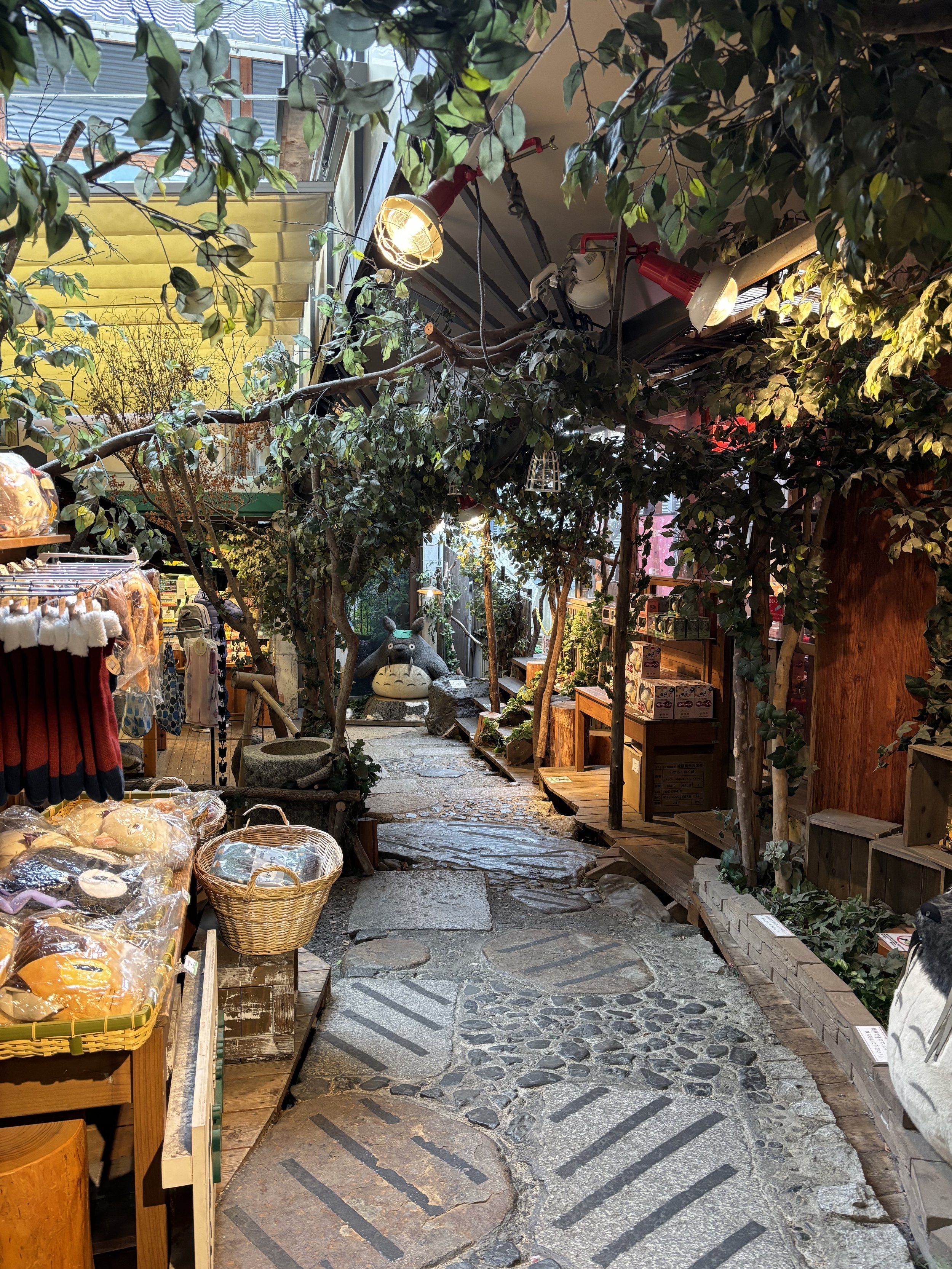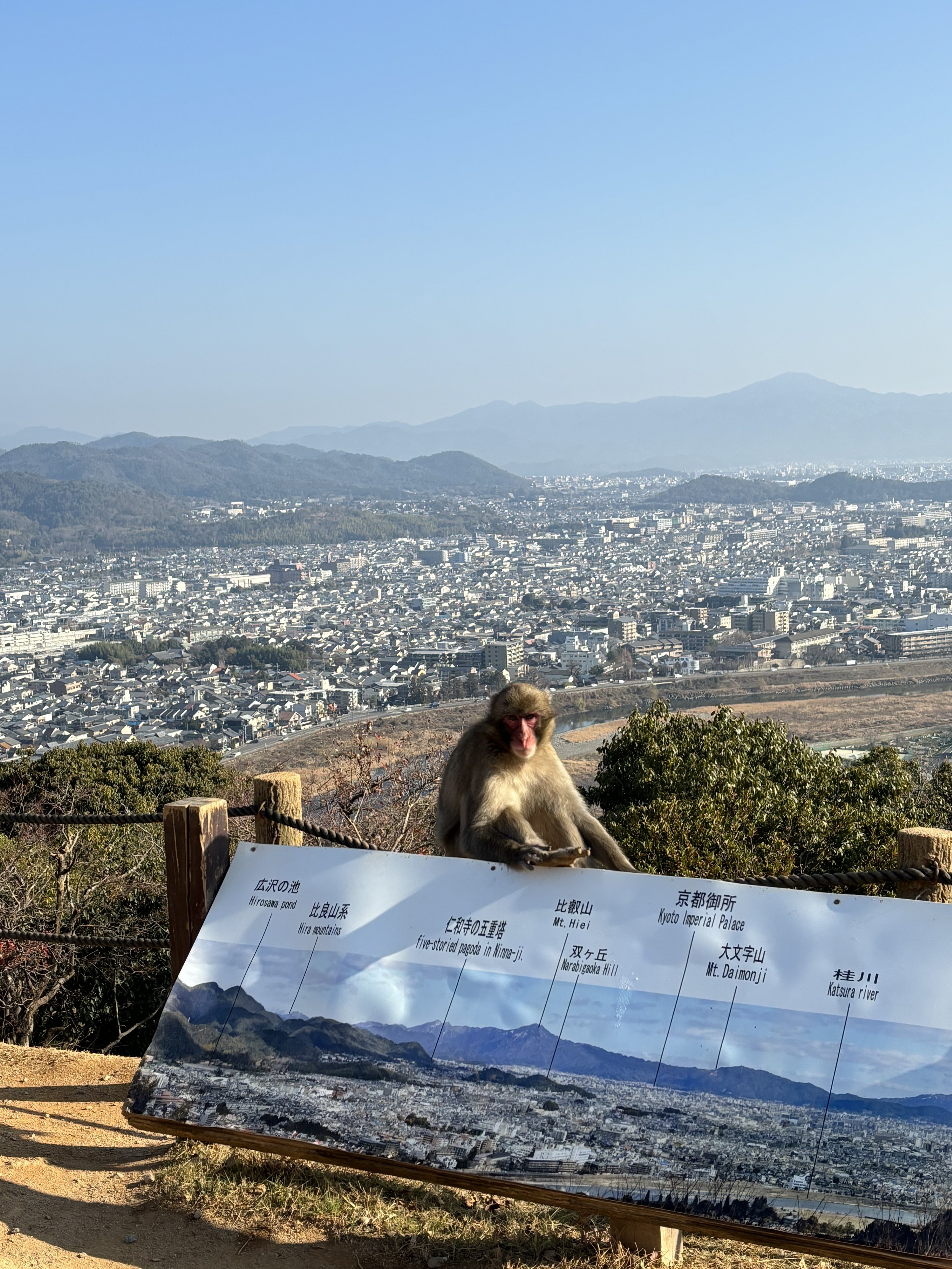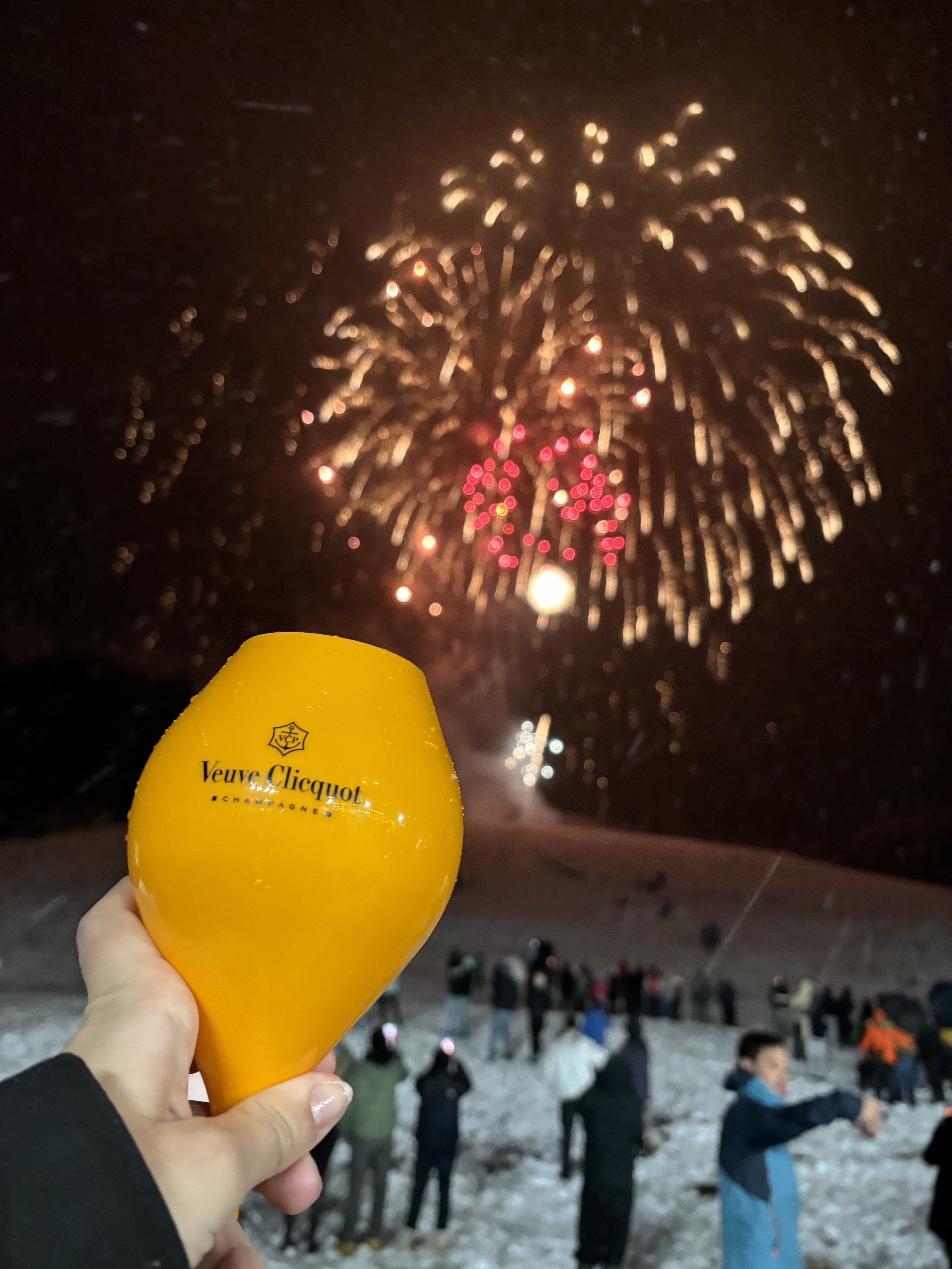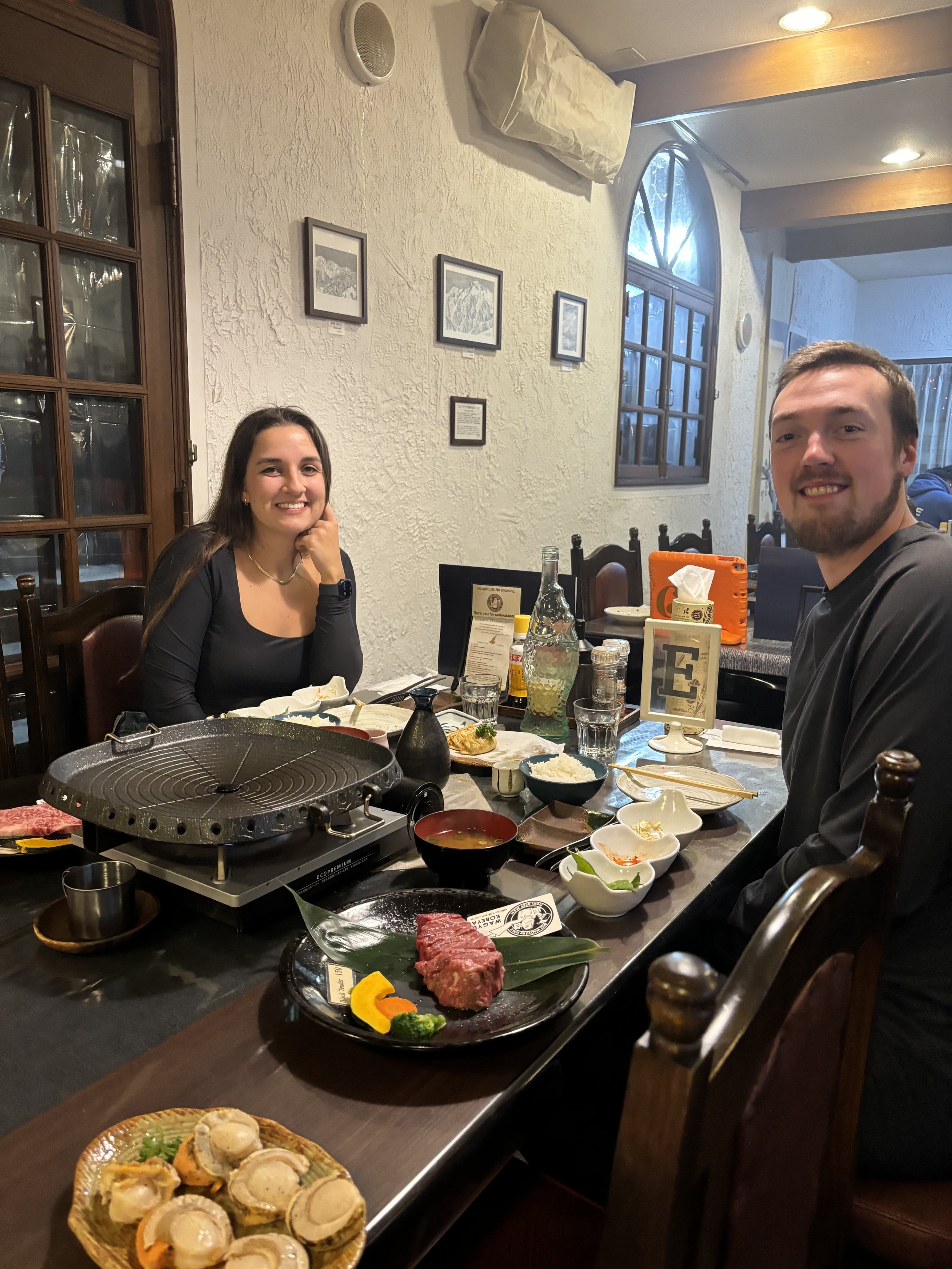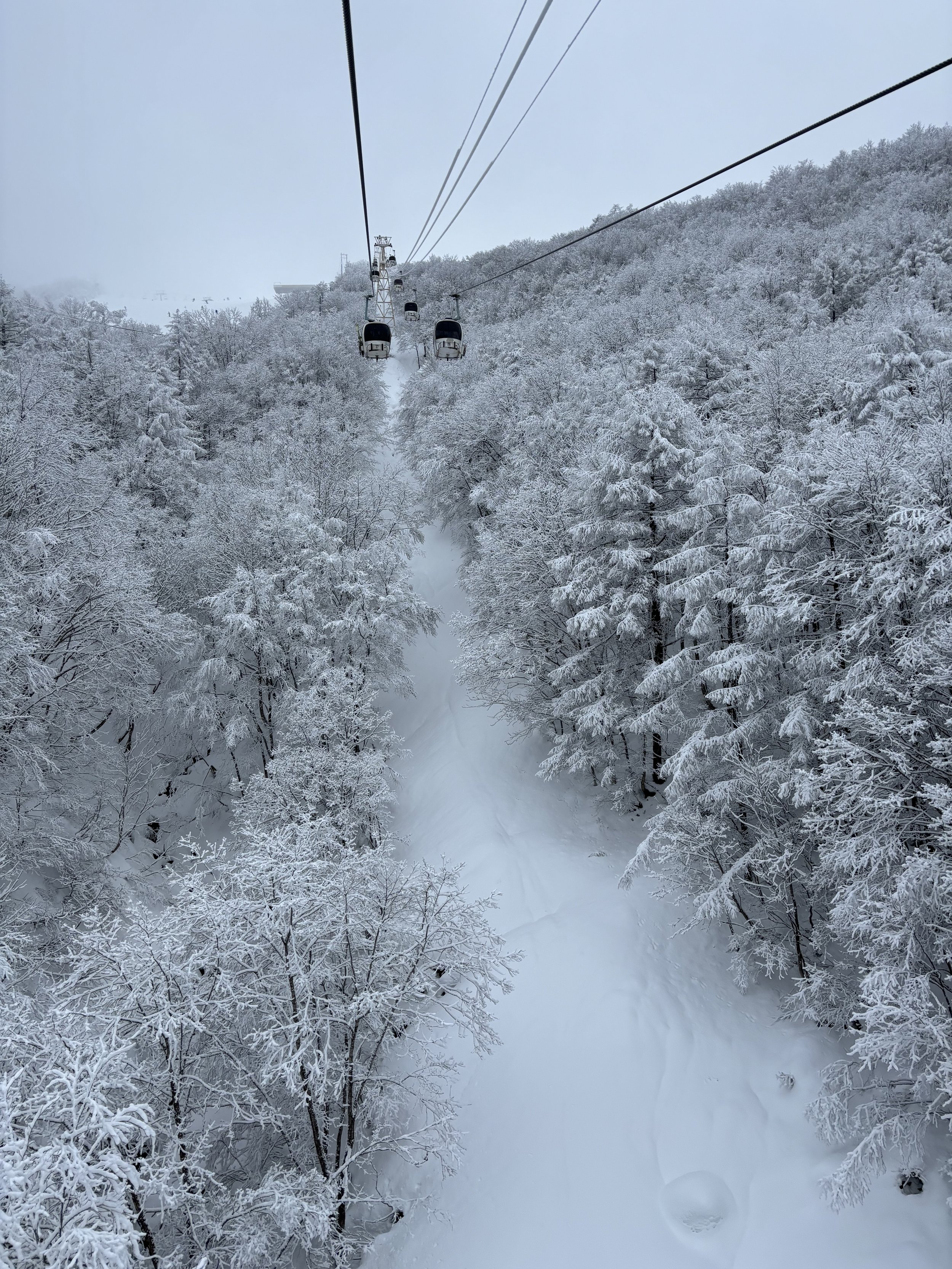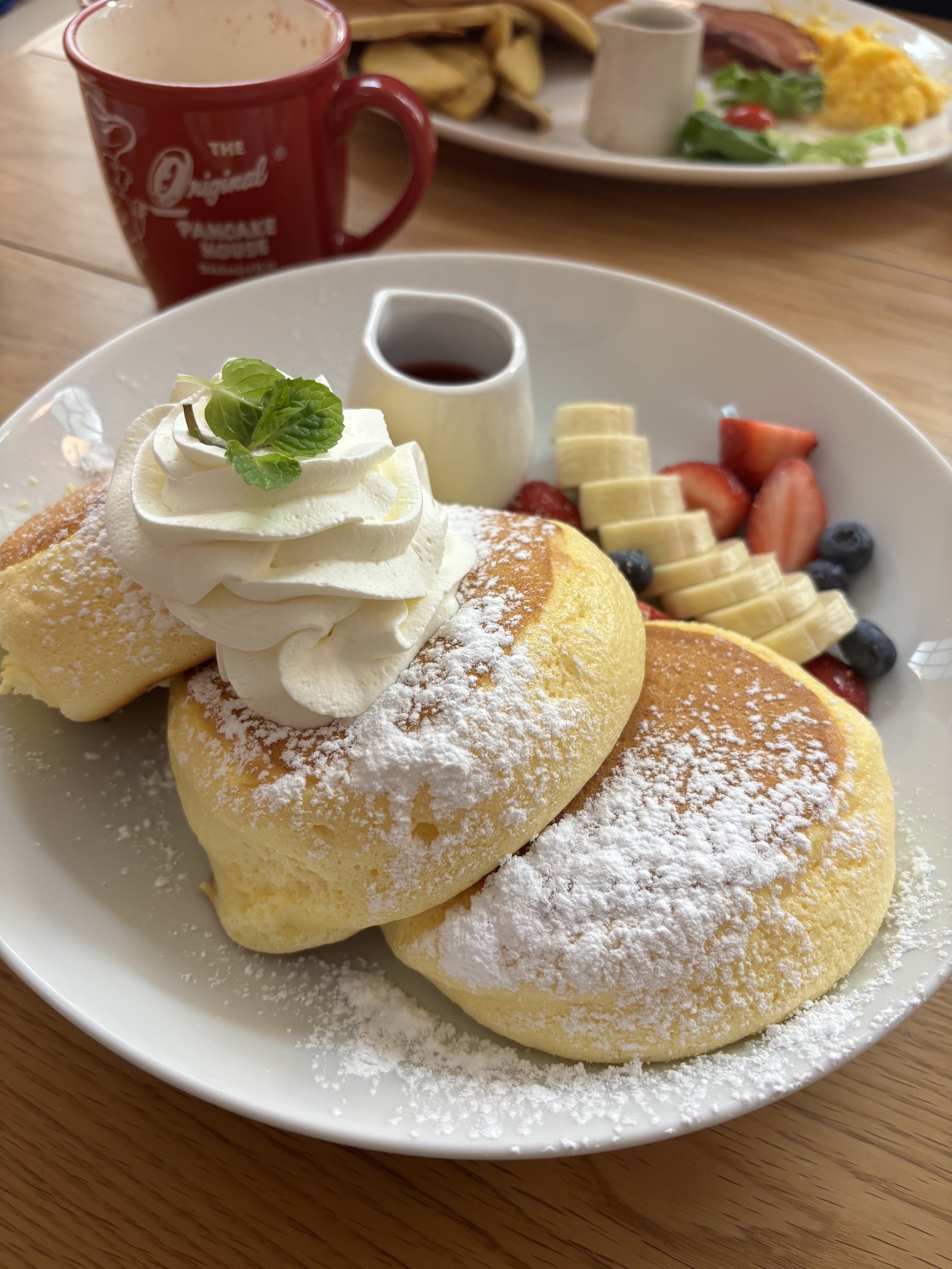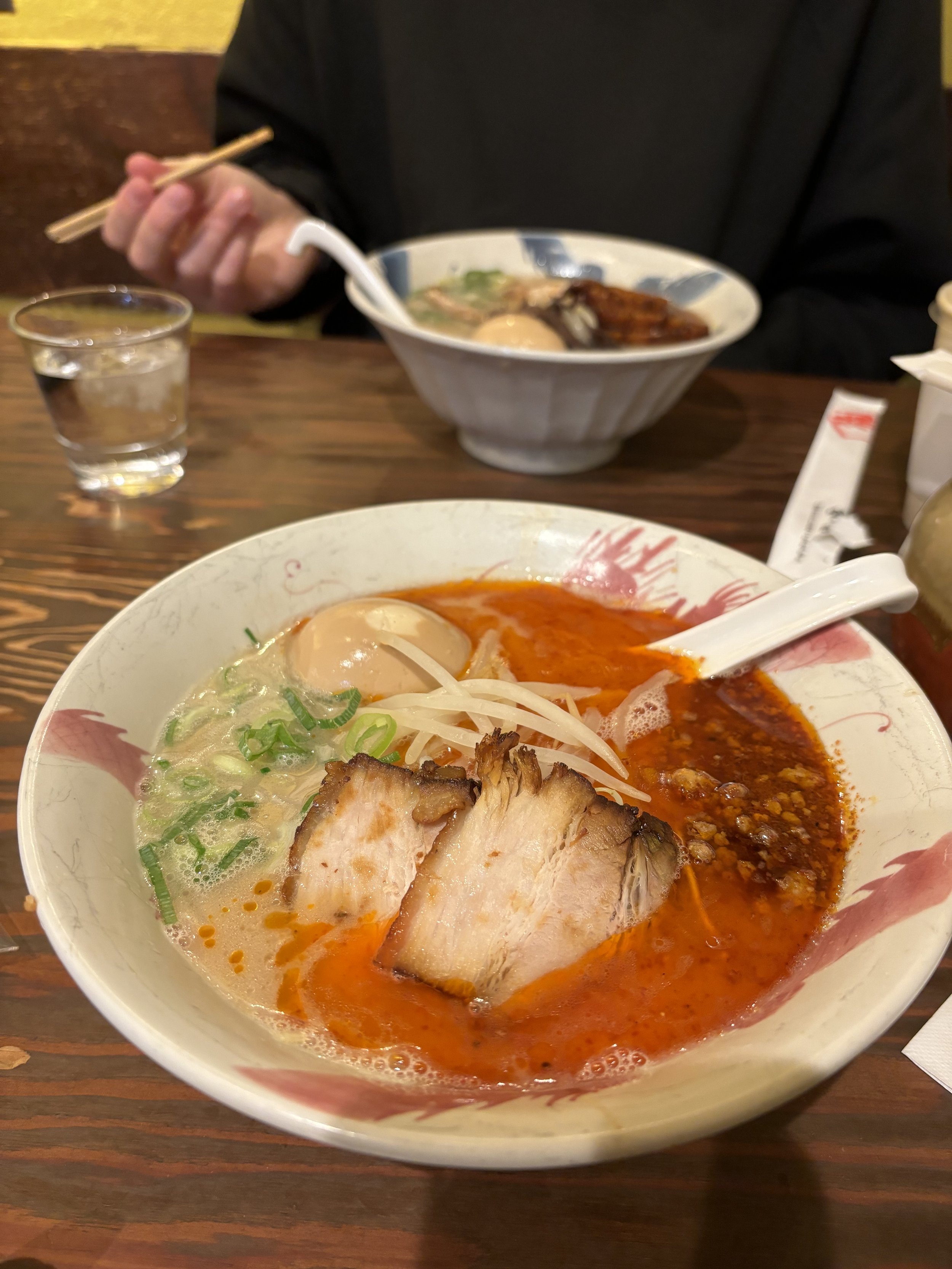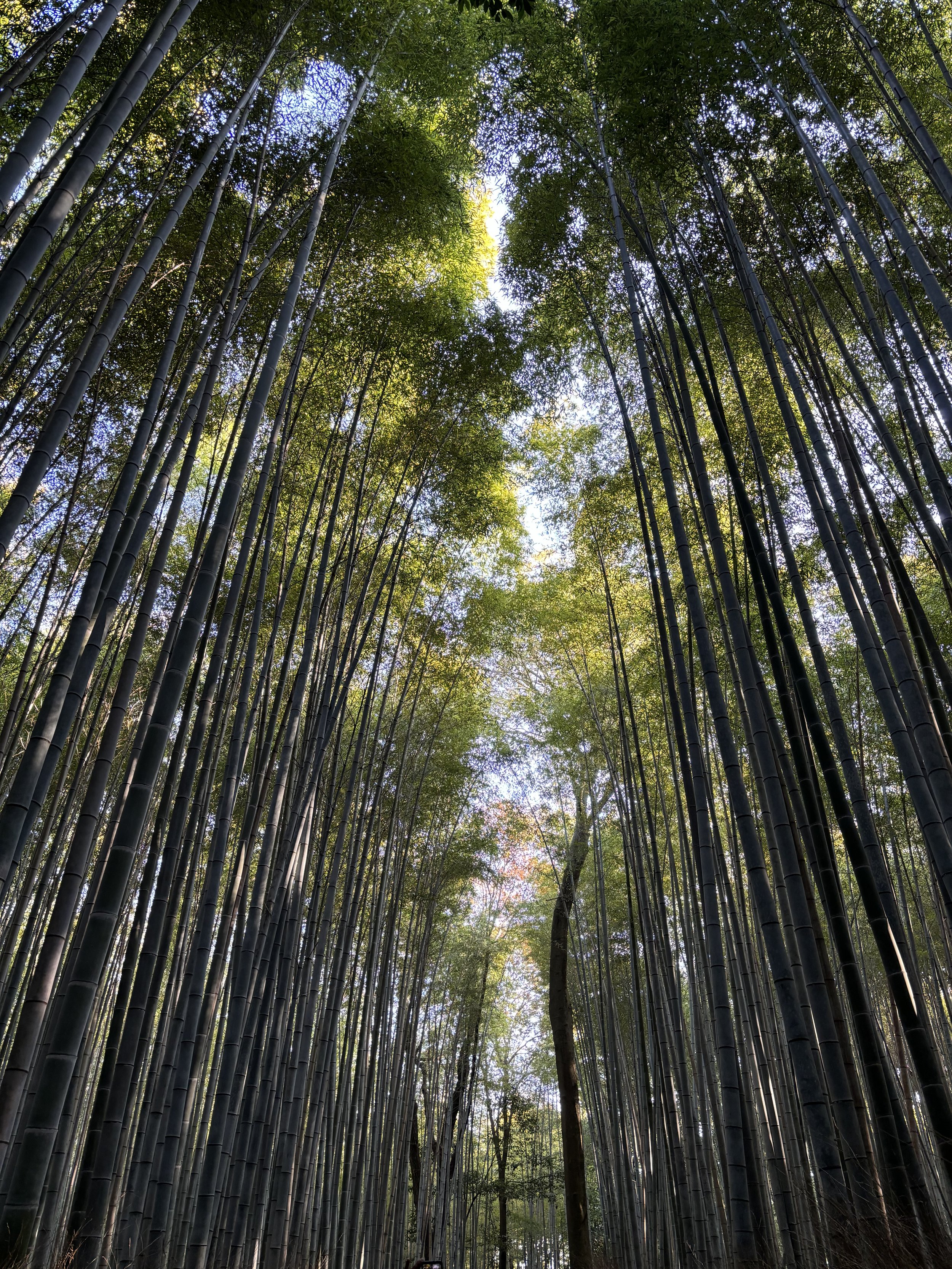Trip to Japan 2024: Kyoto, Hakuba, & Tokyo
The land of beautiful culture, kind people, conveyer belt sushi restaurants, and heated toilet seats
This winter we decided to head out to the land of world-class powder skiing - Japan. While we were there, I figured we would make the most out of the long flight and visit Kyoto and Tokyo as well. Since it worked out with our schedules, we decided to leave right after Christmas and celebrate the new year in Hakuba Valley.
Day one: Flight to Tokyo
We flew ANA nonstop from Japan, a 14 ½ hour red-eye flight that was made less miserable by sitting premium economy. The seats were shaped like a recliner and I loved the provided slippers and noise-cancelling headphones. We both slept pretty well and woke up just prior to landing. We landed at Haneda Airport around 5 am and cleared immigration and customs within 30 minutes. From there, we loaded Suica cards into our Apple Wallets, added 2,000 yen (about $14 USD at the time of writing), and hopped the subway to Shinagawa Station. The Suica card is seamless and charges based on the amount of stops taken, so we tapped our phones as we entered and left the station. I had booked our Shinagawa train (bullet train) in advance since it was a few days before New Years Eve and I was assuming travel would be increased. It cost about $100 USD each for the bullet train from Shinagawa to Kyoto and I was even able to change our ticket to an earlier train since we made such good time getting out of the airport. We got to Kyoto around 9:30 am, dropped off our bags at our ryokan, Kamogawa-kan Inn, and set off to explore the downtown area. A ryokan is a must while in Kyoto - it’s a traditional Japanese inn with tatami-matted rooms, hand-made breakfast, and communal baths or onsens.
We got lunch and our first meal in Japan at Restaurant Miyako, a popular Izakaya restaurant located downtown. After some more exploring, we got dinner at a conveyer belt sushi restaurant called Kaiten Sushi Ginza Onodera Kyoto and called it an early, jet-lagged night.
Day two: Kyoto
After a lovely traditional Japanese breakfast, we set off for the Yasaka-no-To Pagoda in Southern Higashiyama. I wanted to get there early before it got too crowded. This is the site of an ancient temple in the middle of the city and the quintessential Kyoto photo spot. We stopped at a little coffee truck nearby and they had discounts for people wearing scarfs or mittens - which was so cute. The area surrounding the temple is a tourist hub, so we walked around and did some window shopping. I stumbled upon the Studio Ghibli store, so I had to get some Kiki’s Delivery Service chopsticks to commemorate my childhood. Japan has an affinity for cute characters, so we saw adorable things everywhere we went.
Our next stop of the day was the nearby UNESCO-Protected World Heritage Site, Kiyomizu-dera. This classic red temple had a little stalls for Japanese fortunes and signs with stories of its history. I paid 100 yen to get my fortune read and then we entered the UNESCO site for 400 yen each. The view of Kyoto from the top was astonishing and we walked to the site of the easy childbirth temple before leaving. For lunch we had No Name Ramen, a place I had read about on a blog. It has no signs or website, but plays trendy music and has great ramen - if you can find it. They have an ordering kiosk like most other ramen places and we went during an off time so we didn’t wait more than 10 minutes to be seated. We then ventured to Nintendo Kyoto just to look around. We made our way up to the roof where we discovered a Super Mario Bros photo op that we had to take advantage of. Then we made our way to Pontocho, a street famous for having many traditional restaurants, bars, and traditional architecture. For dinner, we got Gyoza Hohei for take-out, a popular dumpling place featured in the Michelin guide. It typically has a long queue but luckily take-out only takes 10 minutes!
Day three: Kyoto
Another breakfast at our ryokan and we set off for the bamboo forest. It took about 30-40 minutes on the subway from downtown Kyoto and while it was neat to see, it was not the highlight of our time in Kyoto. We then walked to the Arashiyama Monkey Park to see the snow monkeys on the top of the mountains. It took a lot of stairs to get up to the monkeys but I loved seeing them in their natural habitat. Our next stop was the famous and another UNESCO-Protected World Heritage Site, the golden temple of Kinkaku-ji. It took a few subway transfers and a decent amount of walking to get there, but the architecture of this temple is phenomenal. It was overcrowded with tourists, but for good reason. Eventually, we made our way back downtown and got sushi yet again at another conveyer belt sushi restaurant.
In the evening, we walked through the shopping district Teramachi-dori and stumbled upon a ring-making shop. I got to hand make my own ring and they engraved it for free - it was such a fun experience and I highly recommend it to anyone traveling to Kyoto. For dinner I had made a reservation in advance at Anzukko, an Izakaya restaurant with amazing dumplings. We only had two full days in Kyoto, but we made the most of it and I truly felt like we saw it all. We didn’t have much for set plans but the must-see sights and some restaurants.
Other restaurants in Kyoto recommended to me that we did not get to were:
Kyo-Chabana (grill station)
Menbou Miyoshi (udon noodles)
Isomatsu (Izakaya)
Isozumi (Izakaya)
Izuju Sushi (Kyoto style sushi for takeout)
Ippudo Ramen
Shofukutei (soba noodles)
The water quality in Kyoto is amazing, so it’s recommended to try the sake and soba. Saba sushi is Kyoto style, which we tried at the first Izakaya restaurant we went to. It’s very different from regular nigiri sushi, the fish is marinated in vinegar and pressed into rice.
Day four: Train to Hakuba Valley
To the snow! I booked a Shinagawa train to Nagoya bright and early on New Years Eve. It was around $83 USD for two tickets and got us to Nagoya in 30 minutes. From there we got JR tickets at the counter and left on a train to Matsumoto. Many blog posts recommend getting the JR pass but it is expensive and didn’t make sense for our travel plans. At the time of writing it is around $750 USD for a 14 day pass, but we paid far less than that for the JR trains we took while in Japan. From Matsumoto, we took the JR East to Hakuba station. It was only $30 USD for the two of us and was literally a subway going through the countryside. Eventually, we made it to Hakuba to some rain and no taxis at the train station. Being the New Yorkers we are, we decided to just walk the mile in the rain to our hotel in the ski village, Resort Inn Seikan. We brought our ski gear but left our skis at home, so we rented skis from Woody’s across the street from our hotel. It was inexpensive to rent and the guys working there are so helpful. For dinner, I made a reservation at Wagyu Kobeya, a yakiniku restaurant, or Japanese BBQ. They have a shuttle that comes to your hotel about 30 minutes before the booking time and will drop you back off at your request. We made our way to Clubhouse, which had live music and was the exact vibe we were looking for. They were having fireworks at midnight on the mountain for NYE, so we ran out a little before midnight to watch from the base of the mountain.
Day five: Skiing Happo One Hakuba Valley
I had purchased lift tickets in advance, which came out to about $60/person per day. Quite the difference in price from what we are used to back in the states. After picking up our passes at the kiosk, we skiied for the rest of the day. When we went back to the hotel around 4 pm, we felt a sudden shaking that I had initally thought was a truck passing. The shaking got severe and right as Paul asked, “is this an earthquake?” an alarm went off in the room yelling EARTHQUAKE, EARTHQUAKE. We had never experienced an earthquake before, but the building was old and we didn’t feel safe in our room, so we made our way down the three flights of stairs as the shaking continued. By time we made it to the lobby, the shaking finally stopped and it was then that we got the earthquake warning to our phones. Things had fallen off the walls and shelves and everyone seemed pretty unsettled. It was a seismic magnitude of 5+ and we continued feeling small earthquakes of lesser magnitude for hours afterward. It turned out to be what they have now deemed the 2024 Sea of Japan Earthquake. A seismic magnitude of 7.4 had struck the Noto Penninsula, about 50 miles west of where we were in Hakuba. This was the worst earthquake mainland Japan has seen since 2011, and to date the death toll has risen to over 160 people, with over 300 people still missing.
After awhile, we decided to go to our reservation at Hakuba Taproom to try to continue as normal. There was another earthquake warning that came to everyone’s phones while we were there so we had to wait outside of the glass building while it passed. We called it an early night and continued to feel small earthquakes for the next few days we were in Hakuba.
Day six: Skiing Happo One Hakuba Valley
With the small earthquakes still going on, we were cautious but decided to go skiing and make the most of our time in Hakuba. For dinner, we went to Issei Japanese Cuisine - NEO"和"食堂 一成. I made the reservation on Facebook in advance and it was such an amazing meal. The katsu was the best I have ever had and it was one of my favorite dining experiences we had while in Japan.
Day seven: Skiing Happo One Hakuba Valley
Another day of skiing that we ended with Blizzard Pizza in the Happo One Village. We loved the entire vibe - from the pizza, pasta, and beer, to the old skis they used as decor. We were sad to leave Hakuba but the next day we set off to Tokyo.
Day eight: Train to Tokyo
Since our hotel was so close to the bus station, we took a bus to Nagano, where we changed to the JR line to Tokyo station. Our hotel was in Shinjuku at the Century Southern Tower Hotel, where we dropped off our bags and went to Ichiran Ramen for lunch. They have Ichiran in NYC as well, but we wanted to try the flagship restaurant. It was some of the best ramen I have ever had and well worth the 40 minute wait to get in. We spent the rest of the evening just walking around Shinjuku and relaxing in our hotel room. At one point we knew we needed to try the 7/11 egg salad sandwich, and I really do get the hype - it is a must try. For dinner we went to Uogashi Nihon-Ichi, a standing sushi bar with fantastic sushi, before retiring for the night.
Day nine: Day Trip to Mt. Fuji
After careful thought on how we wanted to get to Mt. Fuji, I decided to just book a guided tour on Get Your Guide to take us to the mountain. The other option was a self-guided tour that would have resulted in many transfers and waiting for buses and trains. The option we chose included all the sites we wanted to see and costed $80 a person. We went right from the Shinjuku bus stop to Oishi Park, where we could try “soft cream” aka regional ice cream in fun flavors on a black cone. Oishi Park is situated at the base of Lake Kawaguchiko, giving it one of the best views of Mt. Fuji in all of Japan. From there we went to Arakurayama Sengen Park and were given the opportunity to climb the 400 steps to Chureito Pagoda, another famous view of both the temple and Mt. Fuji. The tour gave us a lot of free time at each location to do our own thing, which I appreciated. Because of this, at this stop we also walked to Honcho Street to see Mt Fuji from the town of Fujiyoshida. We had lunch in Oshino Hakkai, a village made up of Mt. Fuji springs - thus boasting some of the best udon and soba in the country. Our final stop was the first station because the fifth station was temporarily closed, and then back to Tokyo.
Day ten: Tokyo
This was my favorite day in Tokyo! We had a 3 am wake-up call and ubered to Sushi Dai. Sushi Dai is a cash-only world famous sushi restaurant in the Toyosu Fish Market that features some of the freshest sushi in the world. We waited in line for about an hour, put our name in and got a 6 am seating, then went and watched the tuna auction, which started at 5 am. We made our way back to Sushi Dai at 6 am and got seated in front of who we presumed was the head chef. We ordered the omakase menu for 5500 yen and were blown away at how great every piece of sushi was. It was probably the best sushi of my entire life and well worth the early morning wake up call and wait.
After sushi, we ubered about 15 minutes to Arashio-beya to watch sumo wrestling practice. I checked in advance to ensure they would be practicing on this particular day, and I was so happy we found a day to go watch. Practice starts around 7:30 am and lasts 2 hours - it is recommended to show up early but we got there at 7:30 am and could see just fine. The practice arena has large windows to allow people to watch from the outside and it was a very unique experience. Sumo wrestling is an important part of Japanese culture and something I wanted to witness while in Tokyo.
We then took the train to the Imperial Palace Garden, walked around and learned about samurais and the ancient history of Tokyo, before heading back to the hotel for a nap. There was a Tim Ho Wan, which we love for dim sum in New York, right by our hotel so we went there for dinner.
Day Eleven: Tokyo
On Saturday we ventured to Takeshita Street near Shibuya. It was highly overcrowded but fun to see all of the colorful shops to the soundtrack of some J-Pop playing throughout the street. We had lunch at a Mexican restaurant nearby and made our way to the shopping district on the neighboring street, which reminded me of SoHo in NYC. We kept walking until we found the Miyashita Park Shopping District, which had new KITH Treats flavors that we had to try. I wanted to see Tower Records while in Tokyo, so before walking through Shibuya Crossing, we walked around each floor of the massive flagship store to browse records and CDs. After making the famous crossing that can have upward of 2,000 people walking through it at one time, we dipped out to the nearest subway and went back to our hotel.
Day 12: Tokyo
On our final day in Japan, I NEEDED to try the fluffy Japanese pancakes. We got to the Original Pancake House a few minutes before it opened, wrote our names down and were seated right away. The pancakes tasted like soft, fluffy clouds and I loved them. It’s probably a good thing we don’t have these at most brunches in NYC. We decided to stick around Shinjuku and walk around, eventually ending up at the Taito Station Shinjuku GameWorld. There are 7 floors with different types of games on each floor, costing around 100-200 yen per game play. It was so interesting to watch all the gamers who seem to just put in one coin and play for hours. Some of them are clearly there every day and were insanely good. I convinced Paul to play a round of Mario Kart with me and I won. Luckily he did not challenge me to a rematch, so we went on our way.
We had our last ramen of the trip at Ramen Tatsunoya Shinjuku, after waiting in the queue for only around 30 minutes. I got the recommended spicy chili ramen and it was delicious. Then we went back to pack and hang out at the hotel before having our last dinner at Himawari Sushi Shintoshin, a conveyor belt sushi restaurant. The sushi was great and it was the perfect way to end our trip.
Day thirteen: Flight home
We opted to take the subway to Haneda Airport since we found it to be easy to navigate and it was quicker than any bus would have been. We used up all of the yen on our Suica cards so it worked out perfectly. Our flight back to JFK was only 12 ½ hours with the east wind and that was a wrap on our wonderful trip to Japan!
Overview of foods to try in Japan:
Fluffy Japanese pancake
Sushi
Yakisoba
7/11 egg salad sandwich
Ramen
Yakiniku (Japanese BBQ)
Wagyu beef
Soba
Obanzai (like Japanese tapas of local vegetables)
Saba Sushi
Katsu
Green tea dessert




